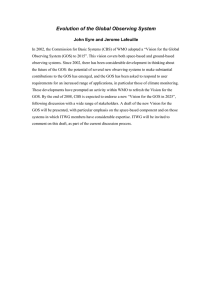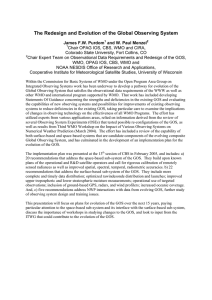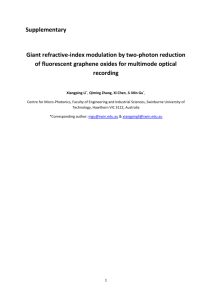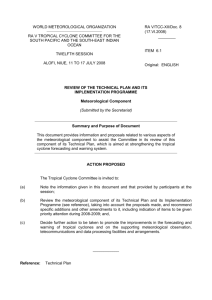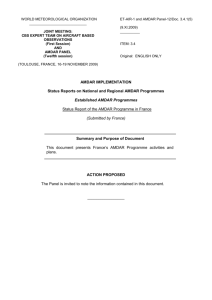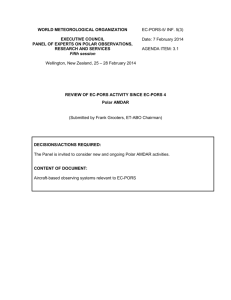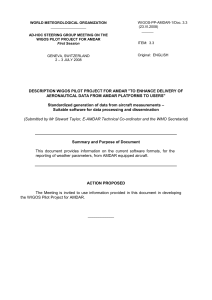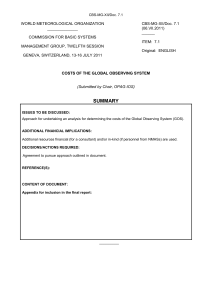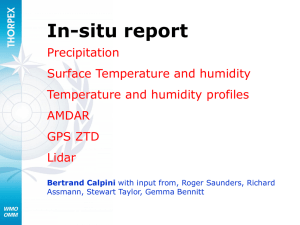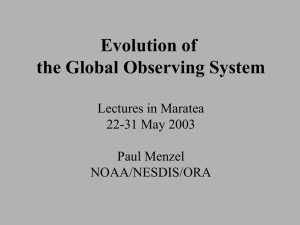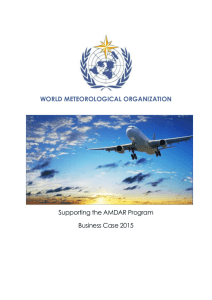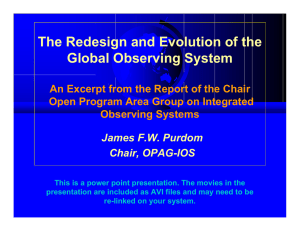Evolution of the GOS in Developing Countries
advertisement
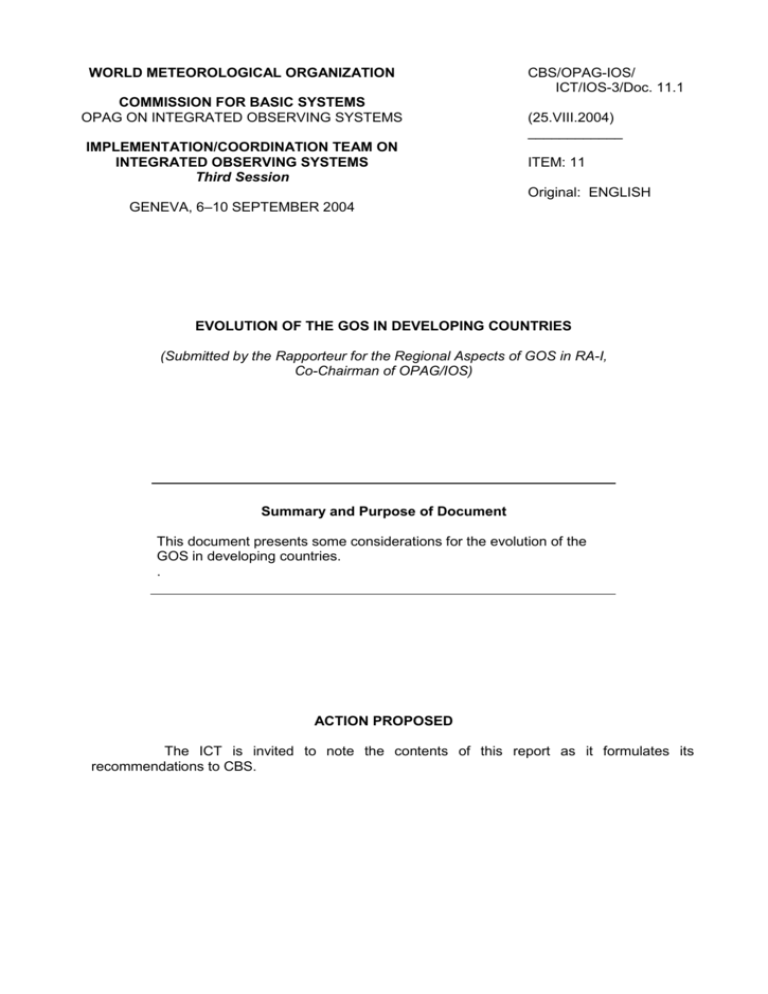
WORLD METEOROLOGICAL ORGANIZATION COMMISSION FOR BASIC SYSTEMS OPAG ON INTEGRATED OBSERVING SYSTEMS IMPLEMENTATION/COORDINATION TEAM ON INTEGRATED OBSERVING SYSTEMS Third Session CBS/OPAG-IOS/ ICT/IOS-3/Doc. 11.1 (25.VIII.2004) ____________ ITEM: 11 Original: ENGLISH GENEVA, 6–10 SEPTEMBER 2004 EVOLUTION OF THE GOS IN DEVELOPING COUNTRIES (Submitted by the Rapporteur for the Regional Aspects of GOS in RA-I, Co-Chairman of OPAG/IOS) Summary and Purpose of Document This document presents some considerations for the evolution of the GOS in developing countries. . ACTION PROPOSED The ICT is invited to note the contents of this report as it formulates its recommendations to CBS. CBS/OPAG-IOS/ICT/IOS-3/Doc.11.1, p. 2 EVOLUTION OF THE GOS IN DEVELOPING COUNTRIES Mr Mahaman SALOUM, service météorologique du Niger Rapporteur for the Regional Aspects of GOS in RA-I Co-Chairman of OPAG/IOS I. Evolution of GOS in developing countries The consideration for the redesign included several issues that involve developing countries. In many areas of Africa, Asia, and Latin America (Regions I, II and III and some tropical areas between 25N and 25S), the current GOS system simply does not exist, whereas in other areas it could be improved. When looking at candidate observing systems, consideration must be given not only to NWP but also to many other applications, including human forecasting. The evolution of the GOS in developing countries must address some of the issues that fall in three categories: (a) lack of public infrastructure such as electricity, telecommunication, transport facilities etc., (b) lack of expertise from people to do the job, training, etc., and (c) funding for equipment, consumables, spare parts, manpower, etc. The lack of infrastructure and expertise may be the result of a lack of funding. The evolution must take into account upgrading, restoring, substitution and capacity building (especially in the use of new technologies). Two aspects need to be considered: the use of the data and the production of the data. It is possible that some countries don not and will not be able to produce the data and will therefore only be users of data. To help developing countries produce data for international exchange, due consideration must be given to the three issues previously identified, i.e. public infrastructure, expertise and funding. Possible approaches towards the redesign were indicated. A first step should be to identify observing systems that were less dependent on infrastructure, expertise, and funding. These are satellite, AMDAR, and AWS. However, a minimum set of reliable RAOBs would be required as a backbone to the upper air network, but also to validate the satellite observations with enough height and accuracy. Migration toward the BUFR code (as a reliable representation of the data) is required. However, replacing RAOBs by AMDAR in many data sparse areas is worth testing. It must be recognised that AMDAR ascent/descent and enroute data will provide little stratospheric information and currently no humidity data (although humidity sensors are being tested). It is imperative that useful approaches be drafted for studying the impact of additional observations (e.g. AMDAR) in regions of scarce conventional observations (e.g. RAOBs) and discuss possible observing system experiments to explore enhancing the observations on these areas. More generally the role of developing countries in the THORPEX through the regional associations should be explored. It is felt that capacity building in some countries needed further attention. Some countries have satellite receiving stations or receive satellite data through the GTS, but lack the expertise to utilise the information ton their benefit. Some countries are acquiring Doppler Radar but need training on how to retrieve the information. For example, Region I has benefited with expanded access to conventional data and satellite imagery through the PUMA Project. This type of project should be expanded to include other data types for routine application (synoptic, aviation, nowcasting). If resources are available, the highest priority should go to (a) maintaining the RBSN and RBCN, noting that GUAN stations are part of the RBSN, and (b) to rehabilitate observing sites in critical locations. Finally, the following recommendations should be taken into account when addressing the evolution of the GOS in developing countries: CBS/OPAG-IOS/ICT/IOS-3/Doc.11.1, p. 3 II. Define geographical areas using advanced techniques to help identify where priority should be if additional funding was available; Encourage regional associations in concert with CBS to define trial field experiments over data sparse areas, for a limited time, to evaluate how additional data would contribute to improve performance at the regional and global scale. A clearly demonstrated impact might make it easier to agree on some coordinated funding mechanism for areas concerned including funding from GEF (Global Environmental Facilities) for climate stations; Examine whether automated stations could become viable, cost effective alternative to manned stations for the surface network in future; In data-sparse areas of the world, it may be more cost-effective to make full use of AMDAR ascent/descent data at major airports; however, the RAOB network still plays an important role in human forecasting; When changes are made to the climate observing systems, the Karl principles should be followed; The telecommunication problem should be referred to the OPAG on ISS and looked at as a priority; Prioritise where the needs are most pressing for VCP or other funding; High priority should be given by the region and secretariat to maintain RAOB network with acceptable performance within data challenged regions. Organization of OSEs Some OSEs on AMDAR are being considered in developing countries, particularly in Africa. One OSE is required to assess (i) the potential impact on NWP predictions of a substantial increase in AMDAR data in a data sparse region; (ii) the relative impact with respect to a single conventional upper station given the availability of these AMDAR data; (iii) the study should last for a period of at least 3 months; (iv) the study should be completed by the end of 2006. AMDAR data suitable for such a study should become available by the end of 2005. Assistance could be provided by the AMDAR Panel and the South African Weather Service in providing guidance on enhancing AMDAR coverage through a data coverage and frequency analysis over the next 2 to 3 years. III. Interest in THORPEX Africa has shown interest in taking part in THORPEX activities. The African Centre of Meteorological Applications for Development (ACMAD) is a regional centre, which is currently undertaking some actions in view of the setting up of a regional THORPEX committee _____________________
